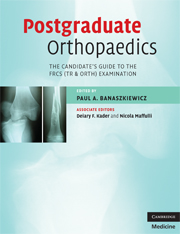Book contents
- Frontmatter
- Contents
- List of contributors
- Foreword by Mr Peter Gibson
- Preface
- Glossary
- Section 1 The FRCS (Tr & Orth) examination
- Section 2 The written paper
- Section 3 The clininicals
- 3 The short cases
- 4 Short case list
- 5 The long cases
- 6 Long case list
- 7 Hand and wrist clinical cases
- 8 Shoulder and elbow clinical cases
- 9 Spine clinical cases
- 10 Hip clinical cases
- 11 Knee clinical cases
- 12 Foot and ankle clinical cases
- 13 Paediatric clinical cases
- Section 4 Adult elective orthopaedics oral
- Section 5 The hand oral
- Section 6 The paediatric oral
- Section 7 The trauma oral
- Section 8 The basic science oral
- Section 9 Miscellaneous topics
- Index
5 - The long cases
from Section 3 - The clininicals
Published online by Cambridge University Press: 22 August 2009
- Frontmatter
- Contents
- List of contributors
- Foreword by Mr Peter Gibson
- Preface
- Glossary
- Section 1 The FRCS (Tr & Orth) examination
- Section 2 The written paper
- Section 3 The clininicals
- 3 The short cases
- 4 Short case list
- 5 The long cases
- 6 Long case list
- 7 Hand and wrist clinical cases
- 8 Shoulder and elbow clinical cases
- 9 Spine clinical cases
- 10 Hip clinical cases
- 11 Knee clinical cases
- 12 Foot and ankle clinical cases
- 13 Paediatric clinical cases
- Section 4 Adult elective orthopaedics oral
- Section 5 The hand oral
- Section 6 The paediatric oral
- Section 7 The trauma oral
- Section 8 The basic science oral
- Section 9 Miscellaneous topics
- Index
Summary
Old versus new
There has been a major change in the way the long case is now conducted. Up until 2006 candidates were allowed 30 minutes alone with a patient to take a history, perform a clinical examination and collect their thoughts together before the examiners would arrive. Candidates would then present the history and demonstrate appropriate positive clinical signs to the examiners before being led away for the discussion part of the long case. The long case history and examination are now conducted in front of the examiners.
This has provoked a mixed response from candidates. Most candidates believe it works in their favour, as examiners are more able to appreciate difficulties encountered in obtaining a history from a poor or difficult historian, which they would not otherwise have directly observed. Other candidates suggest it is one go only with the examination with no room for rechecking clinical signs.
Pass the long case
Failing the long case used to be absolute disaster; there was no coming back or rallying around and the whole examination was failed. For better or worse this has now changed so that you can fail the long case and still pass the exam. There seems to be more emphasis on dividing it into the three sections of history, examination and discussion than previously. One can score a 5 in one section and make it up in the other sections and pass the long case overall.
- Type
- Chapter
- Information
- Postgraduate OrthopaedicsThe Candidate's Guide to the FRCS (TR & Orth) Examination, pp. 17 - 18Publisher: Cambridge University PressPrint publication year: 2008



